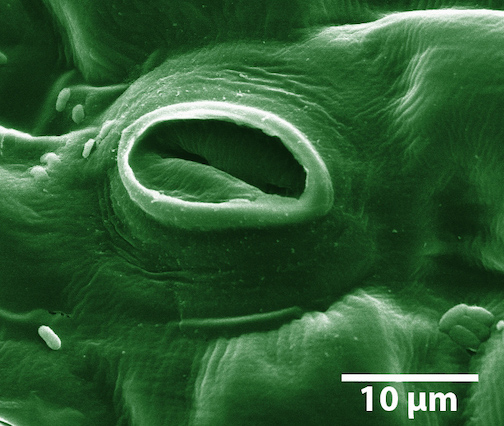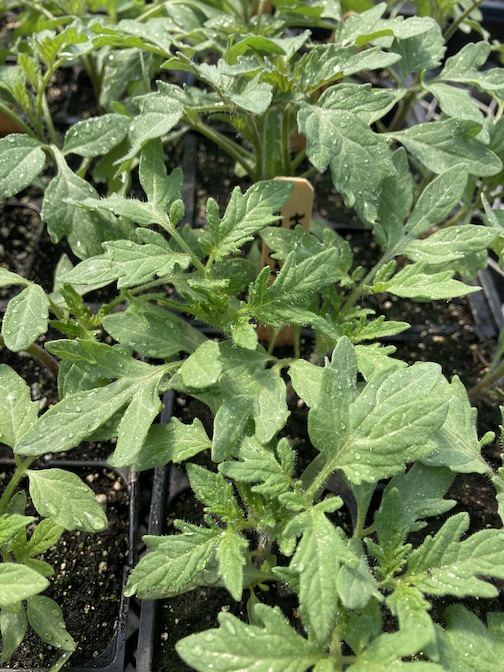By Caleb P. Goossen, Ph.D., MOFGA Crop Specialist
People are attracted to organic growing practices for all sorts of reasons, so I suppose it should not be a surprise that beliefs, practices and approaches between growers can sometimes vary widely. I’m occasionally presented with a question or statement made with the assumption that I use or endorse a growing practice that is popular, and I find myself trying to explain diplomatically why I don’t typically recommend it. Foliar fertilization (the delivery of plant nutrients via sprays applied to leaves) is one of those topics that I find tricky to quickly explain why I don’t think the bang is worth the buck for most growers. A friend once summarized, “It’s like trying to drink a beverage by dumping it over your head!”
Soil Fertility
In natural systems, most plants get all of their mineral nutrition from the soil, specifically the soil water solution — the water that exists in the pore spaces in between solid particles of soil. Mineral nutrients are the elements other than the carbon, hydrogen and oxygen, which make up approximately 95% of a plant’s dry matter, that plants obtain from air and water. Mineral nutrients (the remaining 5% of a plant’s dry matter) are typically divided into macronutrients and micronutrients, separated by their relative abundance in plant tissue. The six macronutrients present in the greatest quantities in plants are, in descending order, nitrogen (N), potassium (K), calcium (Ca), magnesium (Mg), phosphorus (P) and sulfur (S). The eight micronutrients are chlorine (Cl), iron (Fe), boron (B), manganese (Mn), zinc (Zn), copper (Cu), molybdenum (Mo) and nickel (Ni). Other nutrients, like silicon (Si), have been shown to be beneficial to plant growth but are not essential for plants to complete their life cycles.
Seems like a lot to keep track of, doesn’t it? In practice, deficiencies in most of these elements in most of the crops grown in New England are rare — provided that growers are practicing good organic practices to support soil health and fertility. Such practices include correcting initial mineral deficiencies in a soil; typically making annual additions of fertilizers containing N, P and K to address the “law of the return” (i.e., replacing the nutrients that leave soil in harvested crops); and maintaining appropriate soil pH and sufficient soil organic matter for the cycling of nutrients and the support of soil life. Other needed fertility additions are often sporadic, such as occasionally varying what type of lime is used every few years to add more calcium or magnesium, and supplying boron to prevent the primary micronutrient deficiency that is encountered in the region. Boron is more likely than other micronutrients to leach from our soils, and is needed by plants in higher quantities relative to other micronutrients (but only by a few crops which have a higher boron need).
What is Foliar Feeding?

Close-up of tomato leaf stomata, microscopic orifices that can be opened and closed by plants to regulate how much water they let out of their leaves. Courtesy of Wikimedia Commons
Foliar feeding is a method of providing plants with nutrients by dissolving them in water and spraying them on leaves, where they can sometimes enter the leaf through: 1) stomata (microscopic orifices that can be opened and closed by plants to regulate how much water they let out of their leaves, though they open regularly to allow air exchange, letting carbon dioxide in for photosynthesis); and 2) tiny micropores in the leaf cuticle (essentially the waxy skin layer of a leaf, evolved to be nearly waterproof to prevent excessive water loss). The phenomenon of nutrients being able to enter leaves was first proven in several experiments at the University of Michigan about 70 years ago. While it was shown that nutrients can enter plants through their leaves, that rarely happens in nature (carnivorous plants being a big exception) and is not the way that the vast majority of plants have evolved to take in nutrients.
Foliar feeding, an attempt to get dissolved nutrients into plants in the opposite way in which they naturally enter them, is most impactful in distinct circumstances, such as addressing specific micronutrient deficiencies. Macronutrients are needed in such greater quantities by crops than micronutrients that supplying them via foliar feeding is impractical and the concentration needed would greatly increase the risk of leaf burn from the spray. Because both stomata and leaf cuticle have evolved to help a plant limit the amount of water passing through them, foliar-applied nutrients need to be applied in the early morning or late afternoon, when the water they are dissolved in is less likely to evaporate quickly and stomata are more likely to be open. Research has shown that the primary pathway of foliar feeding is not through stomata, however, but instead through micropores in the cuticle layer of a leaf. Stomata are not always open and are often located in the greatest abundance on the underside of leaves, where a spray application is most difficult.

For foliar-applied nutrients to get through the tiny micropores in a leaf cuticle, the plant must be a species with a thinner cuticle layer. Leaf cuticle thickness varies by species and increases with leaf age and exposure to drying environmental conditions — think of a young, soft, greenhouse-grown tomato leaf versus a mature waxy brassica or allium leaf. Micropores are incredibly small, less than 1 nanometer in diameter, and they are lined with negative electrostatic charges, which repel negatively charged nutrient ions (anions, like nitrate, NO3–, the most common form of plant available N in organic growing). They are more likely to let neutral or positively charged ions pass through, e.g., cations like calcium (Ca++) or iron (Fe++). Many of these cations are considered to be relatively immobile within plants and are best used to address a specific deficiency in the leaves they are applied to, or perhaps the surrounding tissue, like fruit, but only if applied prior to the development of that surrounding tissue.
Other than some mined minerals, most organic fertilizers are made from plant and animal products — providing nutrients in a complex mixture of larger organic molecules — and most of those nutrient-containing compounds are likely too large to pass through the micropores in a leaf cuticle. Because of these limitations, it is expected that the majority of the nutrients applied in organic foliar fertilizers are actually entering plants only after they have washed down to the soil below, and interacted with the soil ecology.
How Plants Take Up Nutrients from Soil
Plants do use their leaves to acquire mineral nutrients — just not in the same manner that foliar feeding functions. Most everyone reading this likely knows that nutrients in the soil are “sucked up” by plant roots, but did you know that the phenomenon driving the bulk of this movement is the result of water evaporation from leaves, through their stomata? This is called transpiration, and it creates negative pressure at the top of the water column inside a plant stem, which pulls water up from its roots (just like a small amount of suction at the top of a straw can pull a lot of liquid up it). That root suction is subsequently pulling water (and the nutrients dissolved within it) out of the surrounding soil water solution. Roots also uptake a smaller amount of some nutrients directly at the interface of soil particles and the root (or affiliated mycorrhizae). This direct transfer from soil to root (or affiliated mycorrhizae) also functions via water moving into the root, carrying dissolved nutrients into the plant’s water column and to the rest of the plant.
The foundational principles of organic agriculture include two that I would like to highlight here: 1) Organic farming should sustain and enhance the health of soil, plants, animals and humans as one and indivisible; and 2) Organic farming should be based on the living ecological systems and cycles, work with them, emulate them and help sustain them. These principles hopefully guide organic growers to soil-based production systems where we feed the soil to feed the crop, and where foliar feeding is only likely to provide an additional value in rare circumstances — such as when a “rescue” is needed to correct for a larger systemic issue that has not yet been adequately addressed, e.g., excessively high soil pH limiting a plant’s ability to take up micronutrients.
In trying to figure out why some organic growers are drawn to a practice that seems, to me at least, so counter to emulating natural systems, and potentially expensive in terms of time and labor, if not also purchased inputs, I find myself wondering if perhaps we get a bit caught up in what is possible, instead of focusing on what is most easily practicable. Do we seek out practices that allow us to feel as though we’re having a larger impact or are more in control of complex plant-soil-microbial ecologies than we actually are? I think “doing something” is always going to feel better than not, but I wonder if that allows patterns of behavior to get stuck in our minds, where the overall effects of having done something may give us emotional benefits that are oversized relative to the actual economic or yield impacts they have.
I want to be clear that I have no opposition to liquid fertilizer products, though I do strongly encourage growers to compare fertilizer products on the basis of cost per pound of nutrient being supplied. Dry fertilizer products are frequently the more affordable option. I simply recommend saving liquid fertilizer products for situations where it is only possible to add fertility through irrigation. An example would be seedlings that have been growing for a long time, used up all of the fertility available to them from their potting mix, and aren’t soon to be planted out. Liquid applications of boron are probably the easiest way to get a uniform application of the very small amount needed by some crops like brassicas and chenopods — without providing too much (while boron is a necessary plant nutrient, it can quickly reach levels that are toxic to sensitive crops). I’m also not opposed to applying liquid fertilizers as a spray to plant leaves, because, in the words of my plant nutrition professor, “The best thing about foliar feeding is that as soon as it rains the nutrients go into the soil at the base of the plant where it can take them up!”
So, in the end, do I think that foliar feeding is “bad” or “wrong”? Nope! I’m not trying to yuck anyone’s yum — if it works for you, or even if it’s just a way for you to have more fun and engagement with your growing, then that seems reason enough to me to stick with foliar feeding. I just don’t typically recommend the practice for most situations for organic growers and suspect that it’s not usually a “better” option.
If you are interested in foliar fertilization, keep in mind that it is best performed on overcast days when plants are transpiring less and risk of leaf burn is lowest. Young leaves of plants growing in sheltered greenhouse conditions are the most likely to take in nutrients, and small, positively charged ionic forms of nutrients are the most likely to get through the leaf cuticle. Nutrients that are highly mobile inside plants will be just as mobile from root uptake, and nutrients that are less mobile within plants will not travel very far from the leaves where they were absorbed.
This article was originally published in the summer 2023 issue of The Maine Organic Farmer & Gardener. Subscribe today by becoming a member!
